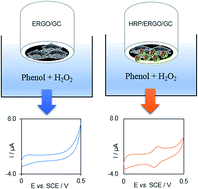当前位置:
X-MOL 学术
›
Anal. Methods
›
论文详情
Our official English website, www.x-mol.net, welcomes your
feedback! (Note: you will need to create a separate account there.)
Highly sensitive biosensing of phenol based on the adsorption of the phenol enzymatic oxidation product on the surface of an electrochemically reduced graphene oxide-modified electrode
Analytical Methods ( IF 2.7 ) Pub Date : 2018-05-25 00:00:00 , DOI: 10.1039/c8ay00528a Amir Kaffash 1, 2, 3, 4 , Hamid R. Zare 4, 5, 6, 7, 8 , Khosrow Rostami 1, 2, 3, 4
Analytical Methods ( IF 2.7 ) Pub Date : 2018-05-25 00:00:00 , DOI: 10.1039/c8ay00528a Amir Kaffash 1, 2, 3, 4 , Hamid R. Zare 4, 5, 6, 7, 8 , Khosrow Rostami 1, 2, 3, 4
Affiliation

|
Phenol determination is an important step of its monitoring to prevent water contamination. Herein, a glassy carbon electrode (GCE) is modified with electrochemically reduced graphene oxide (ERGO) and horseradish peroxidase (HRP) enzyme (HRP/ERGO/GCE). Then, the modified electrode (HRP/ERGO/GCE) has been used for the biosensing of phenol. Using HRP, phenol is oxidized into electroactive o-quinone, which can be electrochemically reduced to catechol. The electrochemical responses obtained in the reduction of o-quinone to catechol are directly related to the phenol concentration. Also, the selectivity of phenol enzymatic oxidation is significantly increased when HRP is used to fabricate the biosensor. In order to enhance the electrochemical responses, ERGO is employed to fabricate the biosensor. The results indicate that the o-quinone/catechol redox couple is adsorbed on the HRP/ERGO/GCE surface and leads to the enhancement of the responses and the sensitivity of the biosensor to determine the phenol concentration. The voltammetric responses of the biosensor, during preparation under specified conditions, are also examined. Using differential pulse voltammetry, a wide linear range of 3.0–100.0 μM and a low detection limit of 2.19 μM are obtained for phenol determination at the HRP/ERGO/GCE surface. Finally, the proposed biosensor has been satisfactorily used to determine the phenol concentration in a tap water sample.
中文翻译:

基于苯酚酶氧化产物在电化学还原的氧化石墨烯修饰电极表面上的吸附,对苯酚具有高度灵敏的生物传感
苯酚的测定是其监测以防止水污染的重要步骤。在此,玻璃碳电极(GCE)用电化学还原的氧化石墨烯(ERGO)和辣根过氧化物酶(HRP)酶(HRP / ERGO / GCE)进行了修饰。然后,修饰电极(HRP / ERGO / GCE)已用于苯酚的生物传感。使用HRP,酚氧化成电ö -quinone,其可被电化学还原为邻苯二酚。减少o时获得的电化学反应苯醌对苯二酚的浓度与苯酚浓度直接相关。同样,当使用HRP来制造生物传感器时,苯酚酶氧化的选择性也显着提高。为了增强电化学反应,采用ERGO来制造生物传感器。结果表明,该Ø-醌/邻苯二酚氧化还原对吸附在HRP / ERGO / GCE表面上,并导致响应的增强和生物传感器确定苯酚浓度的敏感性。在指定条件下制备过程中,还将检查生物传感器的伏安响应。使用差分脉冲伏安法可在HRP / ERGO / GCE表面测定苯酚,得到3.0–100.0μM的宽线性范围和2.19μM的低检测限。最后,所提出的生物传感器已令人满意地用于确定自来水样品中的苯酚浓度。
更新日期:2018-05-25
中文翻译:

基于苯酚酶氧化产物在电化学还原的氧化石墨烯修饰电极表面上的吸附,对苯酚具有高度灵敏的生物传感
苯酚的测定是其监测以防止水污染的重要步骤。在此,玻璃碳电极(GCE)用电化学还原的氧化石墨烯(ERGO)和辣根过氧化物酶(HRP)酶(HRP / ERGO / GCE)进行了修饰。然后,修饰电极(HRP / ERGO / GCE)已用于苯酚的生物传感。使用HRP,酚氧化成电ö -quinone,其可被电化学还原为邻苯二酚。减少o时获得的电化学反应苯醌对苯二酚的浓度与苯酚浓度直接相关。同样,当使用HRP来制造生物传感器时,苯酚酶氧化的选择性也显着提高。为了增强电化学反应,采用ERGO来制造生物传感器。结果表明,该Ø-醌/邻苯二酚氧化还原对吸附在HRP / ERGO / GCE表面上,并导致响应的增强和生物传感器确定苯酚浓度的敏感性。在指定条件下制备过程中,还将检查生物传感器的伏安响应。使用差分脉冲伏安法可在HRP / ERGO / GCE表面测定苯酚,得到3.0–100.0μM的宽线性范围和2.19μM的低检测限。最后,所提出的生物传感器已令人满意地用于确定自来水样品中的苯酚浓度。











































 京公网安备 11010802027423号
京公网安备 11010802027423号